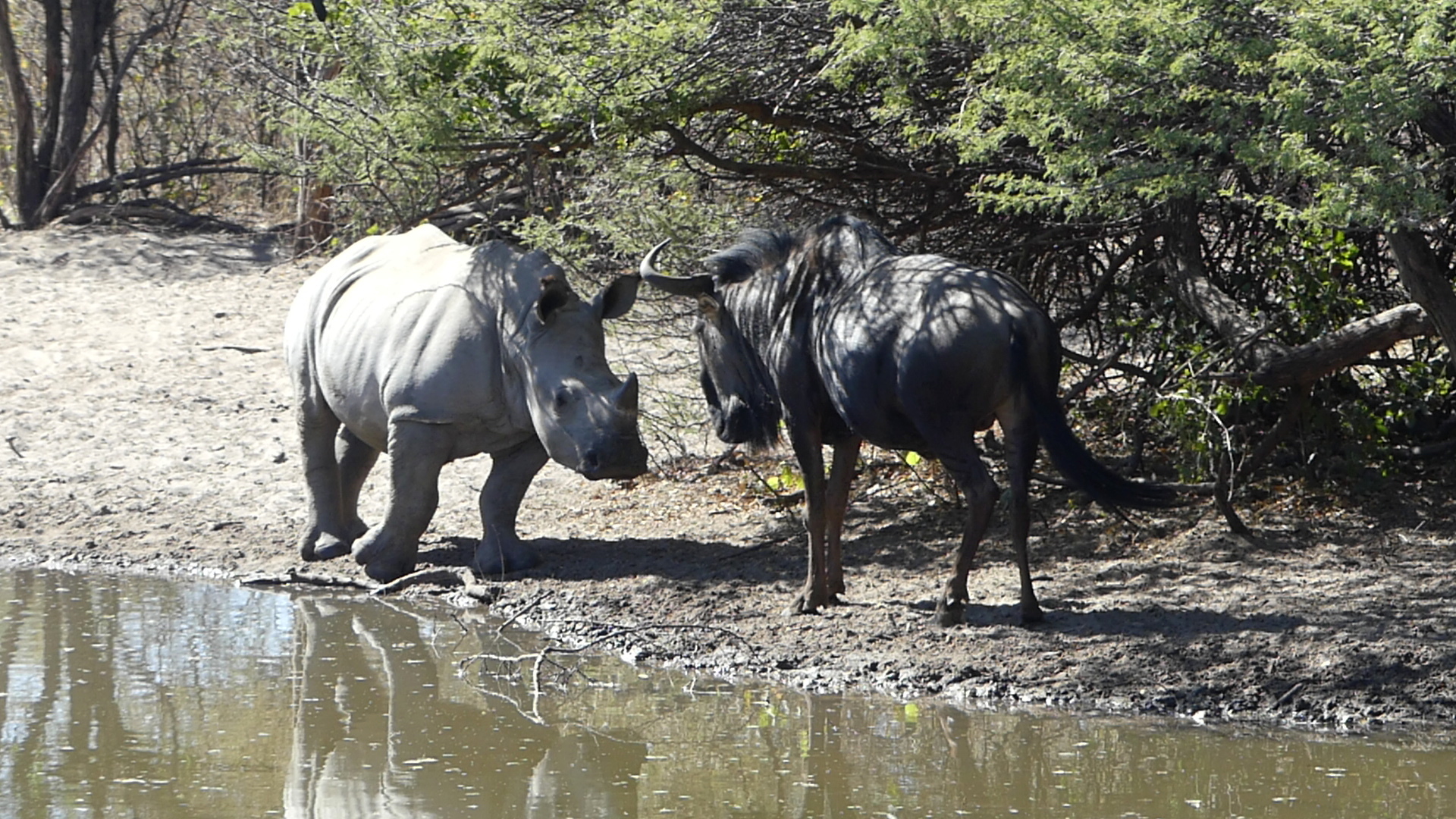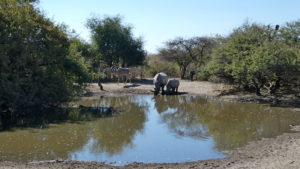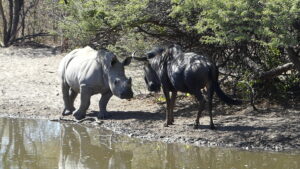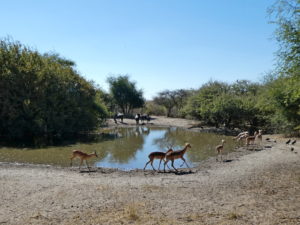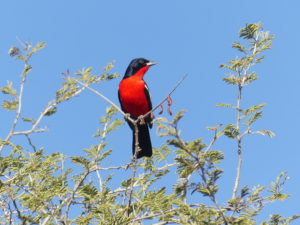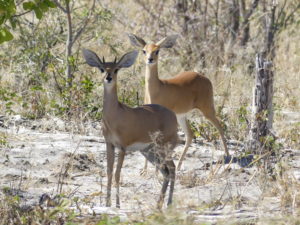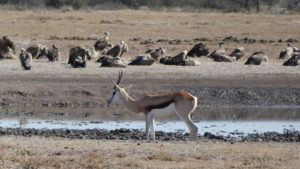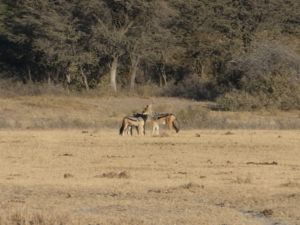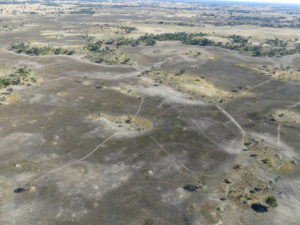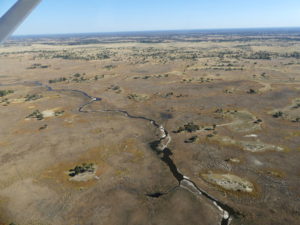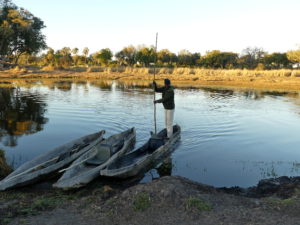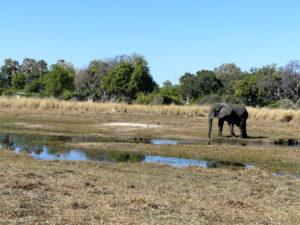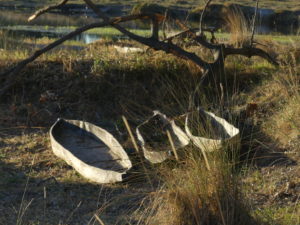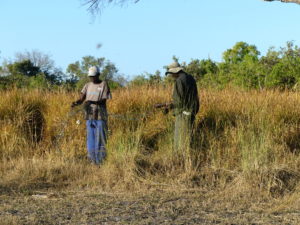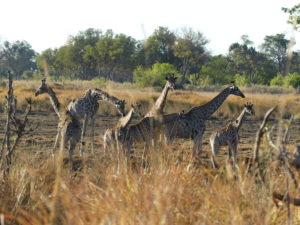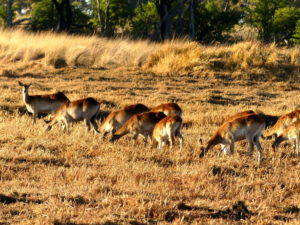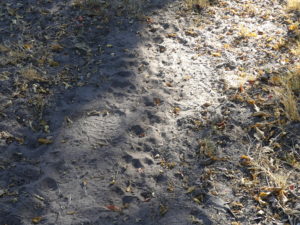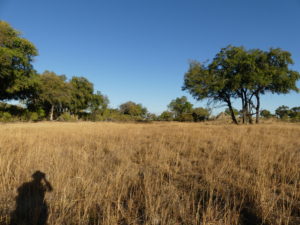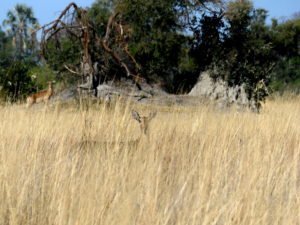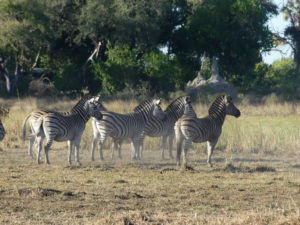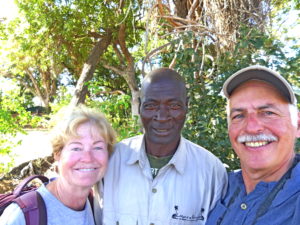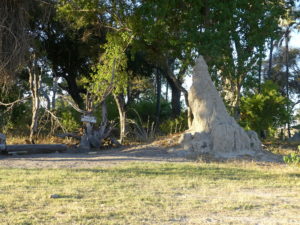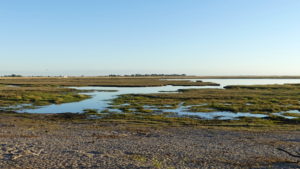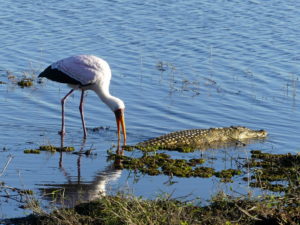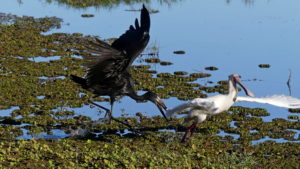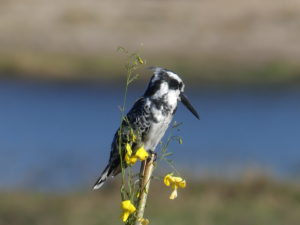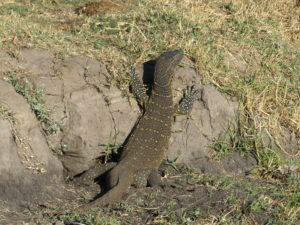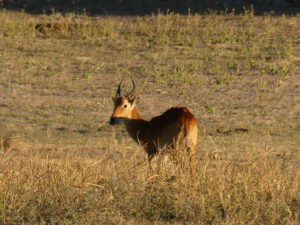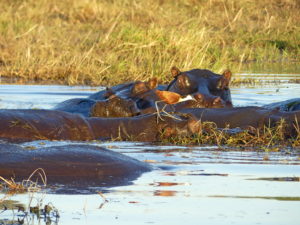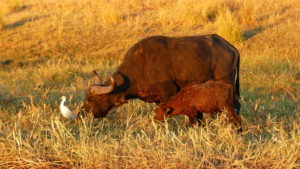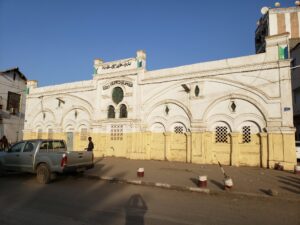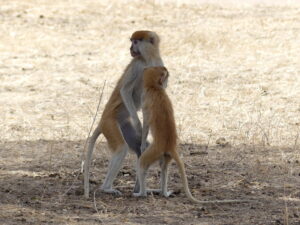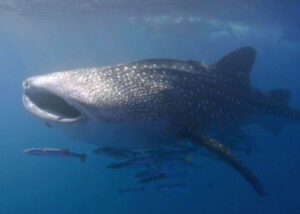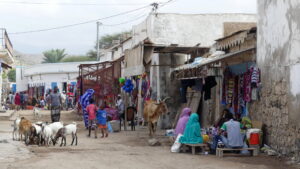In brief: Our safaris at three noted wildlife areas in Botswana were very different from the most common type, driving – partly because water is so vital at this dry time.
Botswana is rich in wildlife parks and all the wildlife – and wildlife stories – one seeks on safari. Three reserves we visited more than measured up to their reputations. In each, we found ourselves doing safaris very different from the most common, driving through. In addition, each demonstrated how water plays such a central role here, especially during the decade-long drought in the area.
Khama Rhino – sit and wait
Sit. Wait. Often the best way to see wildlife is just to hang around patiently, opportunistically. We have frequently been fortunate to see amazing sights in the wild just because we happened to be in the right place at the right time; and we have been unfortunate, at the wrong time or place.
At a couple of waterholes in Khama Rhino park (our first stop in Botswana), we sat and waited – and were fortunate. Water is the essence of life in the wild, and proved quite lively in the hours we spent near it. Wildebeest locked horns and wrestled, or wallowed in the dust.
One of the trio of male blu wildebeest (gnu) continually rubbed himself, pawed and wriggled in this mudhole near the water. At other times, he locked horns with another gnu, playing at what could be deadly competition for dominance in the future.
Mother and baby white rhinos (this is Khama Rhino park after all) alertly drank at the watering hole while an impressively horned kudu antelope wandered past.
Soon, the baby rhino approached one of the wildebeest. They inquisitively confronted each other for awhile, until the wildebeest backed away.
A more serious challenge came when a third, huge rhino appeared. The mother glared at the third rhino until he moved away to the right, but charged him to make sure he kept going. He was too thirsty to depart, it seemed, as he reappeared on the near side of the waterhole…far enough away to stop being a worry for her.
Soon, herds of timid impala tiptoed thirstily past us while wildebeest milled around behind them.
Numerous birds – babblers, louries, doves, bulbuls, hawks – fluttered and twittered and swung through. Several crimson breasted shrikes showed up near the water and in the dry bush as well. Brilliant in the sun.
To top it off, a mother and young giraffe ambled into the clearing for the water. A very fortunate day.
We also saw steenbok antelope a bit farther off, heading toward the watering hole.
Somewhat reluctantly we moved on (driving) to a second waterhole, which was almost as rewarding.
This handsome springbok stepped lively past an uncountable number of endangered white backed vultures.
Black backed jackals appeared at the edge of the clearing around the second waterhole. This is not the ideal photo, but we thought that their appearance, with natural black carpets on their backs, was so thrilling. And they are threatened with elimination as the farmers dislike them.
The Okavango Delta – on foot
It is easy to be dazzled by the natural sights when one drives in safari vehicles around wildlife reserves in Africa. You cover more terrain, can go closer to the animals, while at the same time protected by the vehicle. Also you’re less exposed to weather extremes.
But we have found that the richest experience comes from walking safaris, where you follow in the footsteps of the wild animals – skirting feisty elephants and African buffaloes; tracking elusive lions and antelope hidden in the tall grasses or wild sage; peering through the brush at flitting birds; or quietly sidling up to herds of zebra and giraffe. That was our opportunity over three days on Chief’s Island, at the heart of the UNESCO World-Heritage expanse of the Okavango Delta in Botswana.
The Okavango delta differs from most other deltas, which are typically fan-like river outlets with numerous channels to the sea. Here, normally, waters flow down from the highlands in Angola and, in these flatlands, meander along and pool around high spots throughout the broad Okavango area. The ideal transport is the mokoro, a low-lying, dugout canoe that Delta natives have used since pre-history. But then the water flow just disappears underground into the aridity of adjacent deserts, vanishing from the surface.
Sadly, the delta is not normal now. Along with all its rich wildlife, it is suffering a drought more punishing than at any time over the last decade or more. Only a few, sparse river channels struggle to flow through, while fish eagles forage for any food other than fish. When we flew to our campground in Okavango’s center, we looked in vain across the landscape for water. Yet mostly we saw dry watering holes and the dusty trails made by thirsty wildlife seeking, searching for water.
First view of the Delta from our flight to the camp. Here you can see the hollows, or pans, and the high point of a small island within. The pans should be full of water, but now just show the dusty tracks of the animals of the Delta.
Second view of the Delta from the air. Animals now head to the slight ribbons of water in the main river channels…and we saw only two such rivers meandering through the parched landscape.
At the river channel near our camping lodge, our guide Moka comes to collect us in a mokoro, a canoe hollowed out from a single tree trunk. When we sat in them, the lip of the canoe was barely higher than the water, so our eyes were close to water level. If conditions here had been anything near that norm, we would have done a mokoro safari, an excellent way to see wildlife closely – we were told. But the most we could do was just cross this narrow channel, a two minute ride.
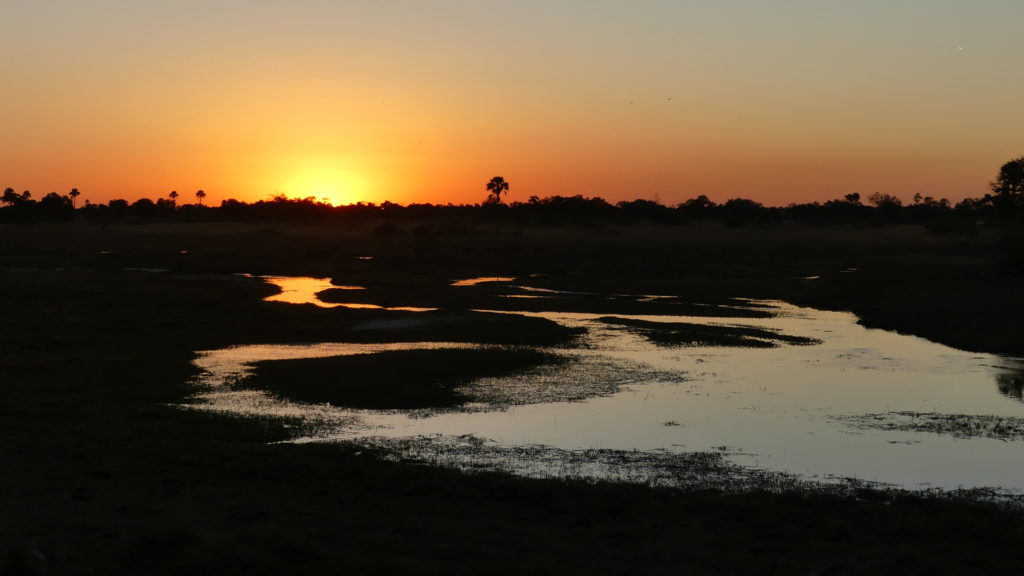
The river channel near our campground meandered a bit into side pools, a miniature snapshot of what the Delta should look like for 250 kilometers or so (150 miles) across but now – in the midst of drought – does not.
Mid-day is the time to rest in the shade, whether you’re working out in the Delta or just visiting for safaris. The animals are more active and thirstier early or late in the day. And mid-day can become quite hot and humid. We stayed in the Delta when conditions were cool most of the day so we could still enjoy watching many animals gathered at the river – our mid-day entertainment channel. The baboons whose troupe crossed the shallow water daily near this elephant were an especial treat for they don’t like wetting their fur. Though some just plodded through, most tried to jump the channel, with more or less successful leaps. We developed an Olympic style rating system for the best – and worst – efforts. Other baboons stood up awkwardly on their hind feet and tip-toed across. And mother baboons hitched their little ones onto their backs before walking on all-fours or tip-toeing on two feet to the other side.
The guides at our camp all had lived in the Delta so were expert at steering the canoe. Moka had once poled one of these about 150 kilometers (100 miles) to the nearest town, Maun, over a span of four days, with three nights camping in the wild on the small islands.
We asked him whether that was dangerous given the lions, leopards and even more threatening wildlife around. He smiled gently at our naivete and said, “Once you know the ways of these animals, you know the way to live with them. Most important thing is to recognize that we are in their home. As long as you are a good guest, letting them be, you are safe.”
Few people live in the Okavango Delta now, mostly workers who staff the safari camps and guide visitors – or anti-poaching militia. Originally the inhabitants were moved out of the Delta because of the tsetse flies and the diseases they carried. But then the interests of tourism and preserving habitat for the elephants and other wildlife took priority. Most of the families live in Maun, the fast-growing tourist hub for the Delta. Some of our group met with people in what is left of a local village. The villagers told of the difficulties of farming there due to the elephants, who are proliferating with no natural predators. The elephants don’t much hesitate to trample whatever is in their way.
Two of the local workers, who live in a village on Chief’s Island, joined us to set up their nets to capture small fish in the river channel, still trickling despite the drought conditions.
One evening we snaked along an antelope trail through tall grasses to reach the shallow channel of our river. On the far bank, a fish eagle was eating after finding one of the few fish within the river. Shortly, a herd of giraffe appeared, with several young ones among them. We tried to go around them so they felt free to drink, a challenge at any time for such a tall animal. They usually spread their forelegs sideways and knock-kneed to reach down, quite a stretch when the water is low. Oddly they followed us rather than moving away, eventually crossing the channel just 30 meters in front of us to reach some tall trees with tasty leaves.
We saw plentiful red lechwe in the Delta, an antelope endemic to southern Africa. Like hippos, they see the water as a source of safety because they can run quite fast in a river or pond, the normal state of the Delta. Their hind legs therefore are quite strong, while their backs slope forward. That capability, as we saw one night, was fortunate for two red lechwe: in front of us a lioness chased but failed to catch them as they passed the central deck of our camping lodge.
Lion tracks, coming toward us. Twice we pursued lions. Once, we heard a lion calling nearby and hustled off in that direction, but found nothing. The second time, we saw two lionesses a few hundred meters across a grassy plain – and followed them. Why do this, you wonder? As a native of the Delta, our guide was familiar with the ways of all the animals. He understood that just respecting their domain and giving them leeway was enough to keep yourself safe. Besides, lions are generally not interested in humans as prey.
So we tried to intercept the path that the lionesses were taking, but, according to the tracks we found, they had diverted to a trail taken by a herd of dozens of buffaloes. We did too, across the plains and into a wide thicket of trees. We approached the buffalo herd, climbing up a three meter high anthill to see what might happen. A few buffalo wandered in, but we did not see the lions again. By contrast, a French couple later reported that they rousted a male lion just 30 meters away from them, though he quickly loped off. That’s how hunts go sometimes, for people like us or for lions too.
Grasslands of the Delta were especially golden in the late afternoon.
The grasses are often waist-high, perfect cover for any animal who wants to hide. We walked within 20 meters of several reedbok and had no idea they were near, until they raised themselves up and fled. What else, you might ask, is hiding in these wispy grasses?
The zebra and antelope kept their distance from us, while we were on foot, but did not seem too worried otherwise. Elephants are either so unconcerned or so impudent that they will just keep on going through you. It’s best, we learned, to steer away from them and the direction they’re headed.
Saying goodbye to our guide Moka, with a selfie. We then waited for our plane at the dirt airstrip where small planes swing in low over the river channel to carry in tourists and supplies. They must, however, check for clearance by eyeing the elephants that often criss-cross the landing area.
To the side of the airstrip is the whimsically marked outdoor airport lounge by the Termite Anthill Bar.
Chobe’s Animal tales – by boat on the river
Why, say, do elephants vigorously swish the reeds they pull up from marshlands, as if the grasses were whips? Our sightings along the Chobe river often demonstrated curious behaviors by the wildlife. Yet, therein lie the tales, as our expert guide would tell them during our evening river cruise.
Nor do the many, diverse animals concern themselves with the political borders of this riverway and wetlands. On one side of the Chobe is Botswana; across the water are Namibia and Zambia.
Wherever they please, however, the animals meander or swim or fly across at will, flourishing on the plentiful grasses and water-based life they find all around them. As for the swishing elephants: before eating the grasses, they thresh out the dirt from the clumps they’ve wrenched out of the gritty soil, material that can weaken the molars they need for eating plants into old age. It’s just dental hygiene!
Morning light along a winding passage of the Chobe River
Why is this yellow billed stork following a crocodile, instead of fleeing? Indeed the stork seemed quite pleased as the crococile approached him and then started to pass by. The tale: the croc’s tail stirs up little river creatures and makes it easier for the stork to eat.
A tale of infringement. Both this open billed stork and the roseate spoonbill roamed placidly together, as they dug their bills into the shallow waters and scrounged for food. At one point, the spoonbill came a bit too close or became too greedy.
Several of these pied kingfishers followed our boat as we moved along the river banks, zipping quickly from one perch to another – or we saw them hovering over potential prey in the waters before diving forcefully to catch one. This one stopped on a slender reed to peer into the waters for his supper. The males and females look alike, with one difference. The male chest shows two bands across the breast, while females have a single one. So, male or female?
The tail of the water monitor lizard is as long as its body. This male lizard seems content, but he has two things on his mind. First, raiding the eggs of the birds that nest in the river banks. Second, chasing two female lizards in turn across the grasses. Each of the two females proved quite disinterested and just a bit quicker than him.
There are several antelope species found only in Botswana and neighboring countries. This was our only sighting of the Puku antelope, well known as the Early Warning System for other animals when a predator is around. On our evening cruise, the South Africans became very excited when we found a pair of puku. The puku, happily, were very unexcited as they detected no dangers other than the South Africans.
Why does an African jacana take the hippo bridge, other than to get to the other side. The jacana not only hitches a ride, but in return grooms the hippos by picking insects from their backs. When not traversing the backs of hippos, which are plentiful in these waters, the jacana appears to walk on water though it’s really tip-toeing along lily pads or other water plants with its long toes. Somewhat irreverently, therefore, it’s called the jesus bird. Female jacanas attract a harem of males, who take on the task of incubating her eggs.
The buffalo is among the most dangerous of animals in the wild. But this mother and calf looked harmless as they placidly munched on the grasses, not at all bothered by the proximity of our boat – or the intrusive egret. They can muster the strength of several oxen (so they can knock over a car), but swim so adeptly that the waters are no barrier for them in reaching the good greenery. Moreover, they remember any injuries or kindnesses, and have been known to pay these back in kind years later.
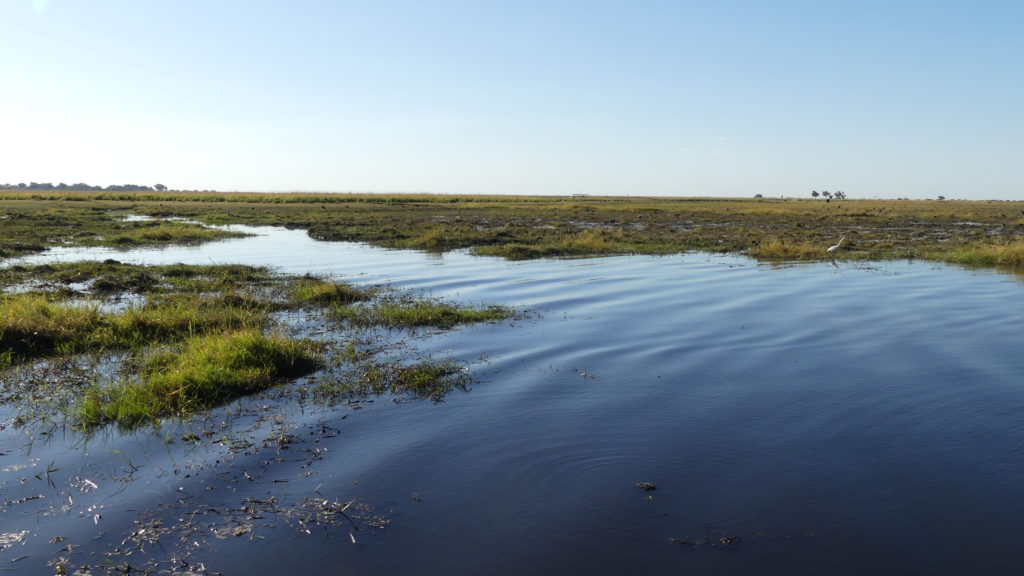
(Also, for more pictures from Botswana, CLICK HERE to view the slideshow at the end of the itinerary page.)


